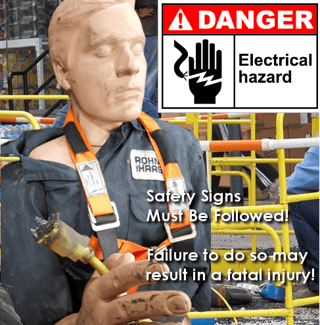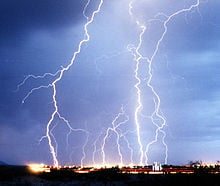As we close out May and therefore Electrical Safety Month, I wanted to share a bit of information for those not familiar with the training requirements for avoiding electrical hazards. Even if you are familiar with the requirements, allow this to serve as a quick reminder to verify that you are in compliance with your relevant OSHA standard.
For many of those in industry who face the risk of injury from electrical shock or other electrical hazards, you must be trained so that you are knowledgeable of these hazards and how to avoid them. Some occupations have a higher risk due to the nature of their job. In fact, OSHA has detailed out the typical occupational categories of employees that face a higher than normal risk of electrical accident. This includes the following:
- Blue collar supervisors*
- Electrical and electronic engineers*
- Electrical and electronic equipment assemblers*
- Electrical and electronic technicians*
- Electricians
- Industrial machine operators*
- Material handling equipment operators*
- Mechanics and repairers*
- Painters*
- Riggers and roustabouts*
- Stationary engineers*
- Welders
*Workers in these groups do not need to be trained if their work or the work of those they supervise does not bring them or the employees they supervise close enough to exposed parts of electric circuits operating at 50 volts or more to ground for a hazard to exist.
For those who are on this list, but do not follow the expection list just above, training may be a necessary need to assist these employees in avoiding electrical hazards and a knowledgeable understanding of the potential of this energy. As you may surmise, proper precautions must be taken to guard against these hazards. Too many employees, too often, are victims of injuries (or worse) because they fail to take these proper precautions to guard against such hazards. Failure to recognize the hazard of contact with energized electrical equipment can be a fatal mistake.
Necessary Training Requirements for Electrical Safety &
Avoiding the Risk of Electrical Shock:
29 CFR 1910.332
www.OSHA.gov
- Employees must be trained in and familiar with safe work practices that pertain to their job assignments or relate to their safety. [(b)(1-2)]
- Are qualified employees permitted to work on or near exposed energized parts? If so, be sure they are trained in the skills and techniques necessary to distinguish exposed live parts from other parts of electric equipment. [(b)(3)(i)]
- Qualified employees must be trained in the skills and techniques necessary to determine the nominal voltage of exposed live parts. [(b)(3)(ii)]
- Qualified employees must be trained in the clearance distances specified in the standard, and in the corresponding votages to which they will be exposed. [(b)(3)(iii)]
Qualified employees are those permitted to work on or near exposed energized parts. Those not not deemed qualified persons, but whom risk similar electrical hazards, shall also be trained in and familiar with any electrically related safety practices. The different training requirements for qualified and unqualified employees are outlined below for reference.
"Qualified" employees must (at a minimum) be able to:
- Identify live electrical parts
- Know their voltages
- Follow proper safety procedures for working on or near exposed live parts
- Know proper PPE to be used
- Know the importance of using insulating and shield materials as well as insulated tools
Training for "Unqualified" employees should cover (at a minimum):
- The risks of energized equipment
- How to protect themselves and others when they work around electricity
- What tasks can be done only by qualified workers
- To always respect warning signs and barriers designed to protect them from live parts
Once again, as Electrical Safety Month comes and goes with the month of May, there is no better time to access your electrical safety needs. If you are in need of either electrical safety training or arc flash training, or simply have a question regarding these topics, contact Safety Training Services today. We look forward to assisting you with your electrical safety & training needs!



 Owning a home may be the American dream, but it can also be a very expensive adventure. When something goes wrong or breaks, the responsibility of correcting the problem lies solely with you, rather than being paid for by a landlord. When it comes to electricity, there's more at stake than just a repair bill and a bit of inconvenience. The energy that powers all of the devices in your home and makes modern life so much simpler can also be a very real danger if you're not properly aware of how to handle it in a safe and effective manner. These ten tips are among those that homeowners should always keep in mind when dealing with electricity for the sake of safety and security.
Owning a home may be the American dream, but it can also be a very expensive adventure. When something goes wrong or breaks, the responsibility of correcting the problem lies solely with you, rather than being paid for by a landlord. When it comes to electricity, there's more at stake than just a repair bill and a bit of inconvenience. The energy that powers all of the devices in your home and makes modern life so much simpler can also be a very real danger if you're not properly aware of how to handle it in a safe and effective manner. These ten tips are among those that homeowners should always keep in mind when dealing with electricity for the sake of safety and security.
 The short answer to “What is electricity?” as OSHA states it, is the flow of electrons though a conductor. Since atoms make up any and everything, and electrons are particles that make up an atom, electrons are therefore everywhere. Because of this, electricity is everywhere. We are going to discuss how this affects us and how it is paramount to take a few extra steps in our daily lives and remember a few tips to keep ourselves safe with regards to electricity and electrical apparatuses.
The short answer to “What is electricity?” as OSHA states it, is the flow of electrons though a conductor. Since atoms make up any and everything, and electrons are particles that make up an atom, electrons are therefore everywhere. Because of this, electricity is everywhere. We are going to discuss how this affects us and how it is paramount to take a few extra steps in our daily lives and remember a few tips to keep ourselves safe with regards to electricity and electrical apparatuses.

